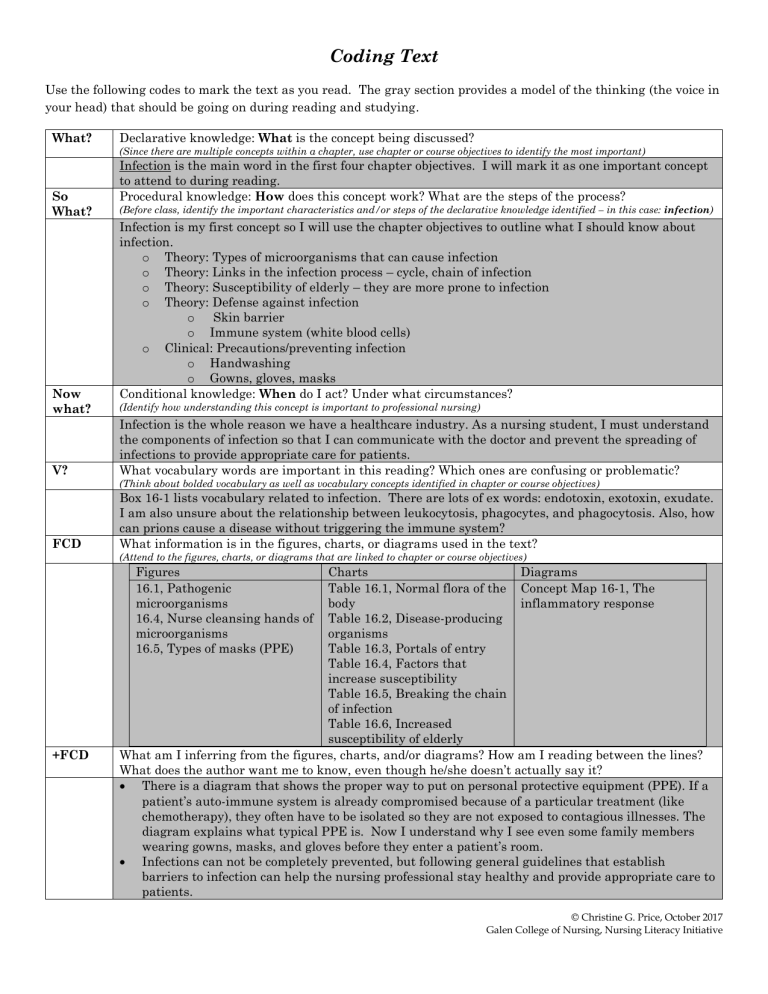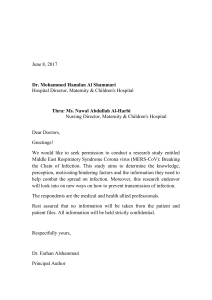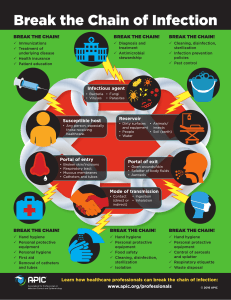
Coding Text Use the following codes to mark the text as you read. The gray section provides a model of the thinking (the voice in your head) that should be going on during reading and studying. What? Declarative knowledge: What is the concept being discussed? (Since there are multiple concepts within a chapter, use chapter or course objectives to identify the most important) So What? Now what? V? Infection is the main word in the first four chapter objectives. I will mark it as one important concept to attend to during reading. Procedural knowledge: How does this concept work? What are the steps of the process? (Before class, identify the important characteristics and/or steps of the declarative knowledge identified – in this case: infection) Infection is my first concept so I will use the chapter objectives to outline what I should know about infection. o Theory: Types of microorganisms that can cause infection o Theory: Links in the infection process – cycle, chain of infection o Theory: Susceptibility of elderly – they are more prone to infection o Theory: Defense against infection o Skin barrier o Immune system (white blood cells) o Clinical: Precautions/preventing infection o Handwashing o Gowns, gloves, masks Conditional knowledge: When do I act? Under what circumstances? (Identify how understanding this concept is important to professional nursing) Infection is the whole reason we have a healthcare industry. As a nursing student, I must understand the components of infection so that I can communicate with the doctor and prevent the spreading of infections to provide appropriate care for patients. What vocabulary words are important in this reading? Which ones are confusing or problematic? (Think about bolded vocabulary as well as vocabulary concepts identified in chapter or course objectives) FCD Box 16-1 lists vocabulary related to infection. There are lots of ex words: endotoxin, exotoxin, exudate. I am also unsure about the relationship between leukocytosis, phagocytes, and phagocytosis. Also, how can prions cause a disease without triggering the immune system? What information is in the figures, charts, or diagrams used in the text? (Attend to the figures, charts, or diagrams that are linked to chapter or course objectives) Figures 16.1, Pathogenic microorganisms 16.4, Nurse cleansing hands of microorganisms 16.5, Types of masks (PPE) +FCD Charts Diagrams Table 16.1, Normal flora of the Concept Map 16-1, The body inflammatory response Table 16.2, Disease-producing organisms Table 16.3, Portals of entry Table 16.4, Factors that increase susceptibility Table 16.5, Breaking the chain of infection Table 16.6, Increased susceptibility of elderly What am I inferring from the figures, charts, and/or diagrams? How am I reading between the lines? What does the author want me to know, even though he/she doesn’t actually say it? There is a diagram that shows the proper way to put on personal protective equipment (PPE). If a patient’s auto-immune system is already compromised because of a particular treatment (like chemotherapy), they often have to be isolated so they are not exposed to contagious illnesses. The diagram explains what typical PPE is. Now I understand why I see even some family members wearing gowns, masks, and gloves before they enter a patient’s room. Infections can not be completely prevented, but following general guidelines that establish barriers to infection can help the nursing professional stay healthy and provide appropriate care to patients. © Christine G. Price, October 2017 Galen College of Nursing, Nursing Literacy Initiative © Christine G. Price, October 2017 Galen College of Nursing, Nursing Literacy Initiative





